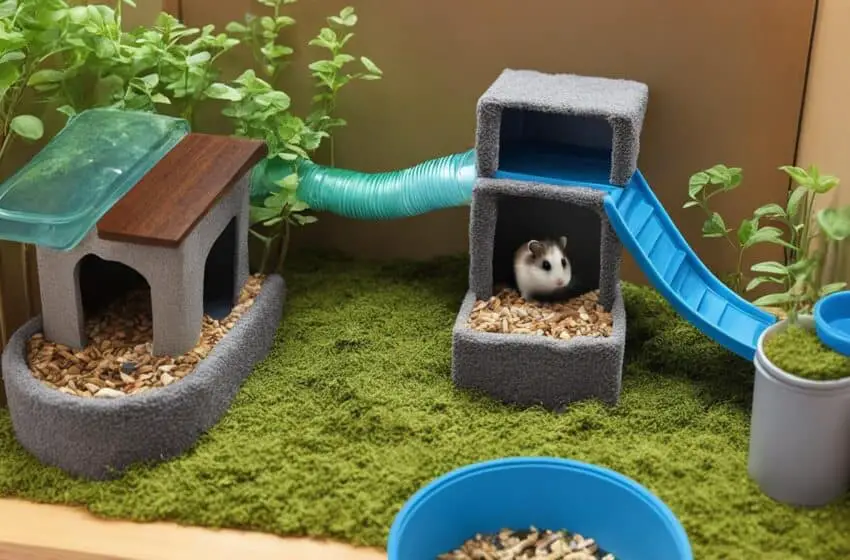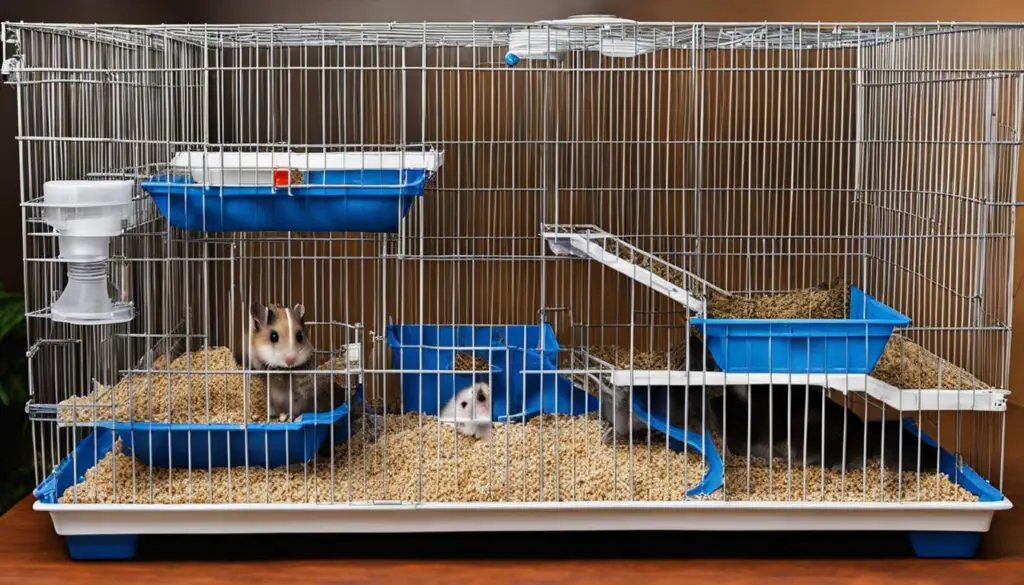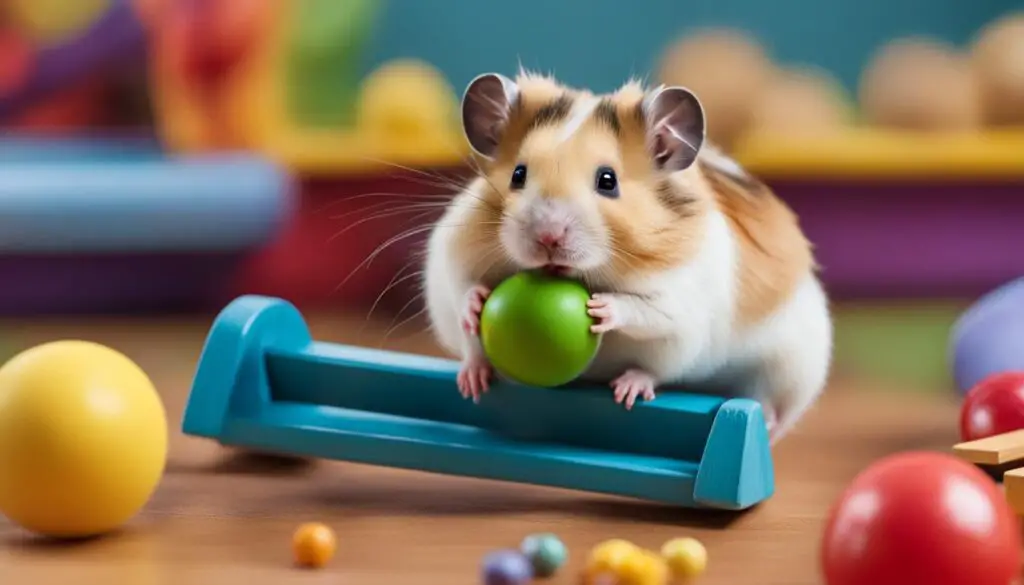Creating the Perfect Habitat for Your Dwarf Hamster

When it comes to providing a comfortable and stimulating environment for your dwarf hamster, a well-planned habitat setup is crucial. By considering their natural behaviors and specific needs, you can create a habitat that promotes their physical and mental well-being. Let’s explore the essential elements to include in your dwarf hamster’s habitat.
Key Takeaways:
- Choose an adequately sized cage for your dwarf hamster, with a minimum of 360 square inches of space.
- Opt for a wire or mesh cage for proper ventilation and avoid aquarium-style enclosures.
- Use safe and absorbent bedding materials like aspen shavings or paper-based bedding.
- Provide a thick layer of substrate to allow for burrowing.
- Incorporate a variety of toys and enrichment items to keep your hamster mentally stimulated.
Cage Size and Type for Your Dwarf Hamster
Providing an adequately sized cage is vital for your dwarf hamster’s overall health. The habitat size directly impacts their well-being and allows them to engage in natural behaviors. It’s important to ensure that your furry friend has enough space to explore, exercise, and feel comfortable in their environment.
The minimum recommended habitat size for a single dwarf hamster is 360 square inches. This provides them with enough room to move around and create a designated sleeping, eating, and play area. However, it’s always better to opt for a larger cage if possible. A spacious habitat gives your hamster more opportunities for physical activity, mental stimulation, and enrichment.
When selecting a cage, consider using a wire or mesh design. These types of cages provide proper ventilation, which is crucial for your hamster’s respiratory health. Additionally, a wire or mesh cage prevents escapes and allows you to easily observe your pet’s activities.
Avoid aquarium-style enclosures for your dwarf hamster. While these tanks may be visually appealing, they can lead to poor air circulation and result in respiratory issues for your hamster. Proper ventilation is essential to maintain a healthy and comfortable habitat.
Remember, the size and type of cage directly impact your dwarf hamster’s quality of life. Investing in a spacious, well-ventilated cage will create a safe and stimulating environment for your furry companion.

Comparison of Dwarf Hamster Cage Sizes
| Cage Size | Dimensions | Recommended |
|---|---|---|
| Small | 12″ x 18″ | No |
| Medium | 24″ x 12″ x 12″ | No |
| Large | 30″ x 18″ x 12″ | Minimum size |
| Extra Large | 40″ x 20″ x 16″ | Recommended |
Bedding and Substrate for Dwarf Hamster Habitats
Selecting the right bedding and substrate is crucial for creating a comfortable and hygienic habitat for your dwarf hamster. Providing a safe and suitable material will not only ensure their well-being but also enhance their natural behaviors. Let’s explore some important considerations when choosing bedding and substrate for your furry friend.
Safe and Absorbent Options
When it comes to dwarf hamster bedding, opt for safe and absorbent materials that promote a clean and healthy habitat. Two popular choices are:
- Aspen shavings: Made from the aspen tree, these shavings are non-toxic and soft, making them ideal for dwarf hamsters. They provide a cozy bedding option and are readily available in pet stores.
- Paper-based bedding: Made from recycled paper, this bedding is not only eco-friendly but also safe for your hamster. It offers excellent absorbency and helps control odors.
It is important to avoid using cedar or pine bedding for dwarf hamsters. These materials can release aromatic oils that may be harmful to their respiratory system and overall health.
Enabling Natural Behaviors
Dwarf hamsters have a natural instinct to burrow and create tunnels. Providing an adequate layer of substrate in their habitat allows them to engage in this behavior. A thick layer of substrate, such as bedding or shredded paper, gives your hamster the opportunity to dig and create cozy burrows.
“Selecting appropriate bedding and substrate for your dwarf hamster’s habitat is crucial to ensure their comfort and well-being. Safe options like aspen shavings or paper-based bedding are absorbent and provide a cozy environment. Remember to provide a thick layer of substrate to satisfy your hamster’s natural burrowing instincts.”
When adding bedding and substrate, ensure that you maintain a sufficient depth to accommodate your hamster’s burrowing activities. Regularly check and replenish the substrate as needed to ensure it remains clean and comfortable for your furry companion.
Enrichment and Toys for a Stimulating Habitat
Keeping your dwarf hamster mentally stimulated is crucial for their overall well-being. Providing them with a variety of toys and enrichment items in their habitat can help prevent boredom and promote exercise. Tunnels, climbing structures, and chew toys are excellent choices to keep your hamster engaged and entertained.
Including tunnels in your hamster’s habitat allows them to engage in their natural burrowing behavior. These tunnels can be made of materials such as plastic or cardboard and should be wide enough for your hamster to easily pass through. Additionally, consider providing multiple entrances and exits to enhance their exploratory experience.
Climbing structures are another great addition to your dwarf hamster’s habitat. These can be in the form of ladders, platforms, or hammocks. Ensure that the climbing structures are securely attached and stable, allowing your hamster to safely navigate and explore their environment. Providing different levels and heights can encourage your hamster to exercise and enjoy their vertical space.
Chew toys are essential for dwarf hamsters as their teeth continuously grow throughout their lives. These toys help wear down their teeth and prevent overgrowth. Opt for safe and durable chew toys made of materials such as untreated wood or safe chewable plastics. Avoid toys with small parts that could be swallowed by your hamster.

Rotating Toys for Continued Engagement
To keep your dwarf hamster engaged and interested in their toys, it’s important to regularly rotate them. Introduce new toys and remove older ones on a weekly or monthly basis. By doing so, you can maintain your hamster’s curiosity and prevent them from becoming bored with their habitat.
“Providing a stimulating habitat filled with different toys and enrichment items is essential for the mental and physical well-being of your dwarf hamster.” – Pet Expert
Recommended Toys for Dwarf Hamsters
| Toy Type | Description |
|---|---|
| Tunnels | Plastic or cardboard tunnels to encourage burrowing behavior |
| Climbing Structures | Ladders, platforms, or hammocks to promote exercise and exploration |
| Chew Toys | Safe and durable toys to help wear down teeth and prevent overgrowth |
Remember to regularly inspect your hamster’s toys for any signs of wear and tear, and replace them as needed. Providing a variety of toys and rotating them regularly will help keep your dwarf hamster mentally stimulated and happy.
Maintaining a Clean and Safe Habitat
Ensuring a clean and safe habitat for your dwarf hamster is essential for their health and well-being. Regular maintenance and proper hygiene practices are key to creating a comfortable environment for your pet.
To maintain a clean habitat, it’s important to clean the cage and remove any soiled bedding at least once a week. Replace the bedding with fresh material to provide a clean and odor-free living space for your hamster.
In addition, spot cleaning should be done daily to remove any uneaten food, droppings, or soiled areas. This will help prevent the buildup of bacteria and maintain a hygienic habitat for your pet.
Furthermore, it’s crucial to place the cage in a quiet area away from direct sunlight and drafts. This will help maintain a stable temperature and prevent your hamster from being exposed to extreme heat or cold.
Regularly inspect the habitat for any potential hazards or signs of wear and tear that may require repairs. By addressing any issues promptly, you can ensure the safety of your dwarf hamster and prevent accidents or injuries.
FAQ
What is the recommended size for a dwarf hamster cage?
The minimum recommended size for a single dwarf hamster is 360 square inches. However, opting for a larger cage will give your pet more room to explore and exercise.
What type of cage should I use for my dwarf hamster?
It is best to use a wire or mesh cage to ensure proper ventilation and prevent escapes. Avoid aquarium-style enclosures, as they can lead to poor air circulation.
What bedding and substrate should I use for my dwarf hamster’s habitat?
Opt for safe and absorbent materials such as aspen shavings or paper-based bedding. Avoid cedar or pine bedding, as they can emit harmful fumes. Additionally, provide a thick layer of substrate to allow for burrowing, which is a natural behavior for dwarf hamsters.
How can I keep my dwarf hamster mentally stimulated?
Include various toys and enrichment items in their habitat, such as tunnels, climbing structures, and chew toys. These items promote exercise and provide mental stimulation. Consider rotating the toys regularly to keep your hamster engaged and prevent boredom.
How should I maintain a clean and safe habitat for my dwarf hamster?
Clean the cage and remove any soiled bedding at least once a week, replacing it with fresh bedding. Spot clean daily by removing any uneaten food, droppings, or soiled areas. Ensure that the cage is placed in a quiet area away from direct sunlight and drafts. Regularly check the habitat for any potential hazards or wear and tear that may require repairs.



